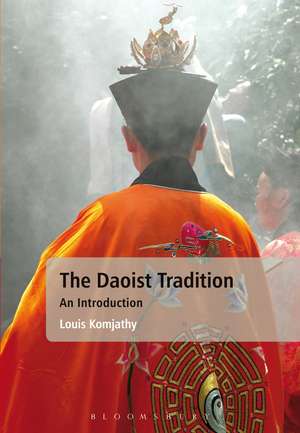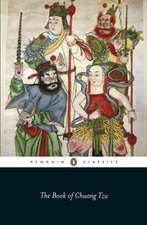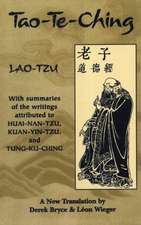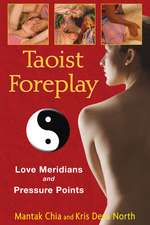The Daoist Tradition: An Introduction
Autor Professor Louis Komjathyen Limba Engleză Paperback – 19 iun 2013
| Toate formatele și edițiile | Preț | Express |
|---|---|---|
| Paperback (1) | 257.36 lei 43-57 zile | |
| Bloomsbury Publishing – 19 iun 2013 | 257.36 lei 43-57 zile | |
| Hardback (1) | 954.45 lei 43-57 zile | |
| Bloomsbury Publishing – 19 iun 2013 | 954.45 lei 43-57 zile |
Preț: 257.36 lei
Preț vechi: 308.62 lei
-17% Nou
Puncte Express: 386
Preț estimativ în valută:
49.25€ • 51.55$ • 40.99£
49.25€ • 51.55$ • 40.99£
Carte tipărită la comandă
Livrare economică 31 martie-14 aprilie
Preluare comenzi: 021 569.72.76
Specificații
ISBN-13: 9781441168733
ISBN-10: 1441168737
Pagini: 400
Ilustrații: 25
Dimensiuni: 169 x 244 x 23 mm
Greutate: 0.68 kg
Ediția:New.
Editura: Bloomsbury Publishing
Colecția Bloomsbury Academic
Locul publicării:London, United Kingdom
ISBN-10: 1441168737
Pagini: 400
Ilustrații: 25
Dimensiuni: 169 x 244 x 23 mm
Greutate: 0.68 kg
Ediția:New.
Editura: Bloomsbury Publishing
Colecția Bloomsbury Academic
Locul publicării:London, United Kingdom
Caracteristici
Includes historical timeline, map of China, images, glossary, text boxes, suggested reading and chapter overviews.
Notă biografică
Louis Komjathy is Associate Professor of Chinese Religions and Comparative Religious Studies at the University of San Diego, USA. He also serves as Founding Co-Chair of the Daoist Studies Group of the American Academy of Religion and as Founding Co-Director of the Center for Daoist Studies.
Cuprins
Part 1: Historical Overview 1. Approaching Daoism 2. The Daoist Tradition Part 2: The Daoist Worldview 3. Ways to Affiliation4. Community and Social Organization 5. Informing Views and Foundational Concerns 6. Cosmogony, Cosmology, and Theology 7. Virtue, Ethics and Conduct Guidelines Part 3: Daoist Practice8. Dietetics 9. Health and Longevity Practice 10. Meditation 11. Scriptures and Scripture Study 12. Ritual Part 4: Place, Sacred Space and Material Culture13. Temples and Sacred Sites 14. Material Culture Part 5: Daoism in the Modern World15. Daoism in the Modern World
Recenzii
Louis Komjathy has composed a comprehensive description of Daoism which combines an abundance of factual information with fresh insights and innovative concepts ... [His] book, based on solid scholarship and personal engagement with the Daoist tradition, is the most comprehensive introduction to Daoism currently available.
Komjathy's book depicts a number of linked but distinct Daoisms, rather than only a single, uniform tradition, by structuring his presentation in terms of both multiple historical periodizations and various overlapping "models of practice and attainment" in which various Daoist practitioners participate across historical periods . . . As a first look at a complex and diverse set of traditions, [Komjathy's] book may be the best of its kind and certainly replaces treatments published prior to the twenty-first century.
The strength of this book is that Komjathy has immersed himself within the living tradition of Daoism and is able to provide us with detailed accounts of the many factions within the community, the various systems of religious leadership and transmission, the different collections of scripture and the traditional sacred places. It would be difficult to find a more comprehensive account of any of the better known religious traditions.
Louis Komjathy has written a masterpiece. It is detailed, insightful and authoritative, and is simply the best guide to Daoism that is available today.
The Daoist Tradition: an Introduction, by Louis Komjathy, offers a clear, unbiased, and comprehensive description of Daoism (Taoism) from its roots in ancient China up to a plethora of modern interpretations, from within as well as outside of the Chinese cultural context. By using a "thematic" approach, scholarly as well as popular sources are treated with objective balance, without favoritism or bias. The "philosophy" vs. "superstition" dichotomy favored by 19h century missionaries and 20h century agnostics clearly does not to represent the Daoist Family inside China. The contemporary world is deeply influenced by Daoism, both within China, as well as throughout the "West" and modern Asia. Highly recommended for the general reader, as well as dedicated scholars.
Louis Komjathy has presented us with a comprehensive history of Daoism that demonstrates once and for all that it is a tradition that--while multifarious--contains important themes, ideas, and practices that demonstrate a continuous development from the classical period to the modern world. Finally, a completely integrated history of Daoism that breaks the half century hegemony of the outmoded scholarly view that this tradition is deeply bifurcated, a religion that completely departs from the texts it claims as its foundations.
Komjathy's book depicts a number of linked but distinct Daoisms, rather than only a single, uniform tradition, by structuring his presentation in terms of both multiple historical periodizations and various overlapping "models of practice and attainment" in which various Daoist practitioners participate across historical periods . . . As a first look at a complex and diverse set of traditions, [Komjathy's] book may be the best of its kind and certainly replaces treatments published prior to the twenty-first century.
The strength of this book is that Komjathy has immersed himself within the living tradition of Daoism and is able to provide us with detailed accounts of the many factions within the community, the various systems of religious leadership and transmission, the different collections of scripture and the traditional sacred places. It would be difficult to find a more comprehensive account of any of the better known religious traditions.
Louis Komjathy has written a masterpiece. It is detailed, insightful and authoritative, and is simply the best guide to Daoism that is available today.
The Daoist Tradition: an Introduction, by Louis Komjathy, offers a clear, unbiased, and comprehensive description of Daoism (Taoism) from its roots in ancient China up to a plethora of modern interpretations, from within as well as outside of the Chinese cultural context. By using a "thematic" approach, scholarly as well as popular sources are treated with objective balance, without favoritism or bias. The "philosophy" vs. "superstition" dichotomy favored by 19h century missionaries and 20h century agnostics clearly does not to represent the Daoist Family inside China. The contemporary world is deeply influenced by Daoism, both within China, as well as throughout the "West" and modern Asia. Highly recommended for the general reader, as well as dedicated scholars.
Louis Komjathy has presented us with a comprehensive history of Daoism that demonstrates once and for all that it is a tradition that--while multifarious--contains important themes, ideas, and practices that demonstrate a continuous development from the classical period to the modern world. Finally, a completely integrated history of Daoism that breaks the half century hegemony of the outmoded scholarly view that this tradition is deeply bifurcated, a religion that completely departs from the texts it claims as its foundations.














